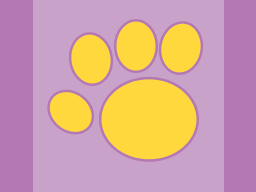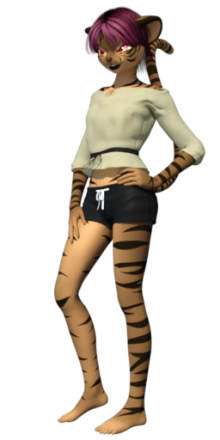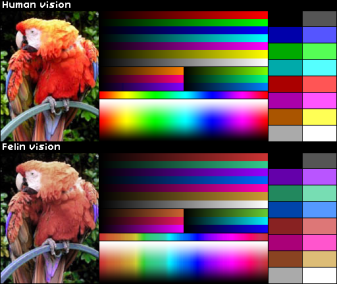Felin
| Felin | |
|---|---|

|
|
| Homeworld | Firrhna Prime |
| Allies | Space Huns, Terrans |
| Enemies | The Nation |
| Morphology | Humanoid |
| Kardashev scale | 1.5 |
The felin are the race of sentient bipeds who inhabit the planet Firrhna and the space that the Council controls. The term "felin" derives from their word for "people", fel (fel).
Biology and Sociology

The felin resemble for all intents and purposes large, bipedal cats. Their faces are generally fair in appearance, and somewhat between a human and animal. They have a full-body coat which comes in many colors and patterns. Felin are almost always somewhat gynomorphic — not androgynous — as though the females tend not to have very large breasts if any at all, the males look decidedly girly. The exceptions are those uncommon females with larger breasts, and the extremely rare bearded males, such as the three heroes described in the lore. The rarest variations of all are the Blessed or felhru (felRu), who are hermaphroditic in nature, but never have breasts or beards. The felin are usually hardier than their fair appearance would signify, and can land from significant heights with little to no damage. Felin can live for roughly 200 Earth years, barring unnatural causes. They reach physical maturity around 30, and begin to look old-aged around 160.
Civility
Felin are curious and peaceful, as they value comfort and personal freedoms above other options. It means that every single Felin interaction is based on a version of consent they require; anyone not considering how the other may feel on certain events is considered ill-tempered or simply mentally ill. A civil felin asks before anything but waging war. Because of this easygoing nature, life on Firrhna is relatively peaceful, and mostly stable.
Sexual Biology
Felin are capable of near-perfectly controlling their fertility. Any felin can do this, except for the felhru who are always infertile. It takes up to a week before the change finishes, and most felin go infertile through their daily life. Because of drastically reduced risk of unwanted pregnancy, felin are usually very sexually open; a known cause of culture shock for visitors. They don’t mate for life; rather, a given felin has a preferred partner who’s likely but not guaranteed to be the other parent of at least one of their children. Family units involving several parents and their offspring living together are not uncommon.
Because of their openness and their friendly nature, physical closeness is paramount to felin society; they are on the whole very clingy and likely to hug at the very least. Their androgynous nature means that the felin have an incredibly weak concept of gender norms, and because of this felin are usually bisexual and bi-romantic, with a minor preference either which way, only actively seeking out the opposite sex when intending to reproduce.
Vision

Felin vision could be considered a form of color-blindness when compared to baseline human vision.
Because of the compression and desaturation in the red to yellow range, the felin language colloquially has a single word for all three, nevla (nevla), which usually refers to orange. In return, Felin are very good at spotting movement in daylight, and seeing at all in the dark. They have a small degree of sight into the infrared range which may be part of their night vision. The noticeable difference in the blue/violet range may be related to how plant life on Firrhna Prime is mostly lilac.
FLO (Brain Compartmentalization)
Because the felin brain is actually relatively simple compared to human brains, it can be trained to compartmentalize sensory inputs from the top and bottom halves of the body, a biological skill that is not as instinctive as switching their fertility on and off. This skill is known as fhe-la orthim (Fe la orþim), the top-bottom divide, fhelathim (Felaþim) for short. This is most commonly used in high-risk occupations where the felin must multitask without distraction. FLO is commonly taught to fighter pilots and various other professions where the hands and eyes can’t afford to be distracted.
Culture
The felin resemble an odd mix of cultural types. Originally a combination of aesthetic reminiscent of the Japanese and Greek cultures of Earth, a healthy dose of late '70s/early '80s western Earth fashion and style, inherited from the interception of TV signals from that period of human culture. Felin like good food, and have a population-wide preference for meat over vegetables. Felin use metaphors based on books (and in modern times movies and games), using things like “paragraphs” as vague time units for example.
Media and Entertainment
Felin theater is best described as Japanese kabuki meets Ancient Greek drama. The audience is seated on sloped stands, about five rows of varying length, with a catwalk running through the middle towards the stage. Actors usually play certain archetypes and/or historical characters, identified through their costumes and/or over-sized wigs. Mostly the wigs. Practice stages are much simpler and easier to erect, having only a single row of seats and less elaborate set designs, if any. Music in theater is mostly diegetic — played by the actors on stage — with the sole exception being dramatic drum stings provided by a stagehand sitting in the corner between the catwalk and main stage. Stagehands, not unlike those in kabuki, provide effects and set changes, and hand actors their props.
Popular characters include, but are not limited to:
- historical characters such as the Leader, Healer, and Hunter
- the Alien
- the Explorer
- the Fool
- the Lover
- the Model
- the Mother
- the Pervert
- the Princeling
- the Salesman
- the Scholar
- the Swindler
- the Virgin
- the Warrior
Most of the non-historical roles have various associated proper names, but they are usually referred to by title.
Television technology allows a single play to be watched by far more than a measly five rows would allow. Even so, most television shows are basically performed in front of a live studio audience. TV performances typically use four cameras; one high up for wide shots including some of the catwalk, two on either side, and one next to the catwalk. Theatrical performances, recorded for TV or live, also serve to educate the young. Educational shows are simple moralism and typically gain most of their mileage from the Lover and Virgin characters, often more of the same and in various gender combinations.
The felin have intercepted many Earth TV signals dating back to the '70s. After a lot of restoration work, TV shows are broadcast with best-guess subtitles and music. The more popular shows serve as a basis for all-felin recreations.
Groups and Institutions
Professions in felin culture are divided into Paths, representing the proverbial path that a felin walks. Each Path has a few different conglomerations of practitioners, forming institutions. The Path of the Hunter is usually represented by the Travelers, who make their base in the orbital space station, and the Wildcats, a galaxy-wide police force whose lower-ranking members usually serve as town guards or municipal police forces. The Path of the Scholar is expressed in several large universities, including the prestigious Blackshard — their motto: “Investigate everything, doubt everything.” Then (not necessarily an institution but nonetheless present) there’s MKI, a multi-planetary technology group that does a little of everything from weapons to agricultural technologies. Their motto is “right or wrong, science is science.”
Religion
Early felin commonly believed they were made by a “will of the planet” and that stars were their dead ancestors. The first wave of scientific insight slowly squashed this belief and replaced it with several rival theories. Felin have no gods but they do engage in fervent hero worship, often asking themselves, “what would [hero] do?” The Will of the Planet is now used purely metaphorically.
Felin give their dead viking funerals, no matter the Path that the deceased followed. A river will do, though proximity to the ocean is preferred. The dead felin is placed on a simple boat, almost a canoe, holding a burning wick in their hands. As the boat drifts off and eventually burns and sinks, those close to the deceased launch bottle rockets with cards attached to them, whereupon they've written well-wishes. This is the origin of the common phrase “you’re not dead until you’ve boarded the boat.” When diving, it is considered a grave insult to intentionally disturb any remains, should you encounter any.
Writing
Felin have two scripts in common use. One is an alphabet, the other a syllabary. The alphabet is more often used. There are also two number systems, quinary and hexadecimal. Most felin use quinary, as they don’t tend to count very high. Scholars and merchants prefer hexadecimal.